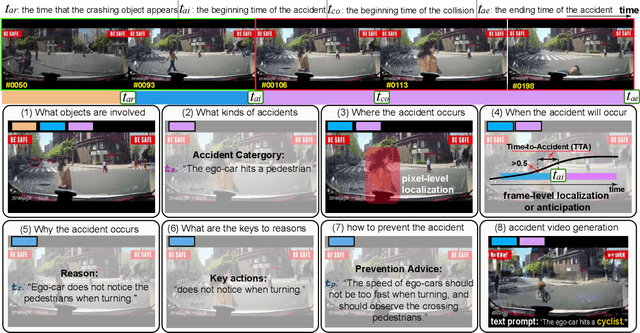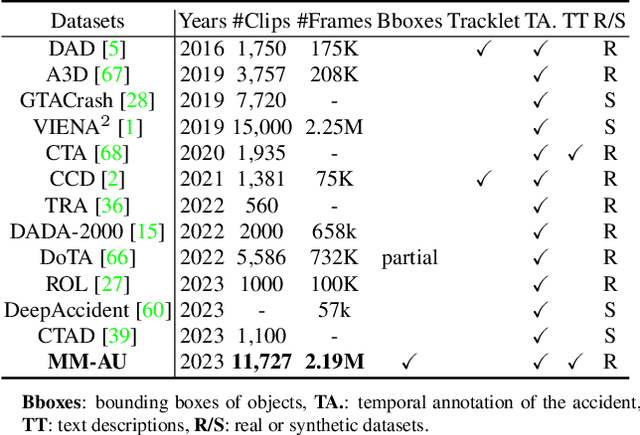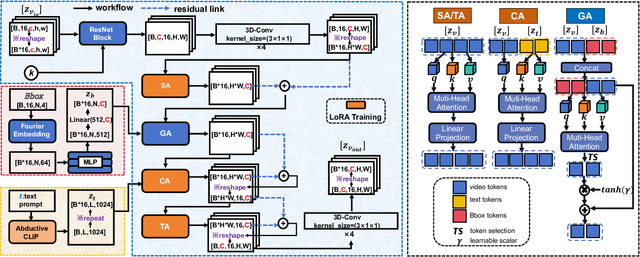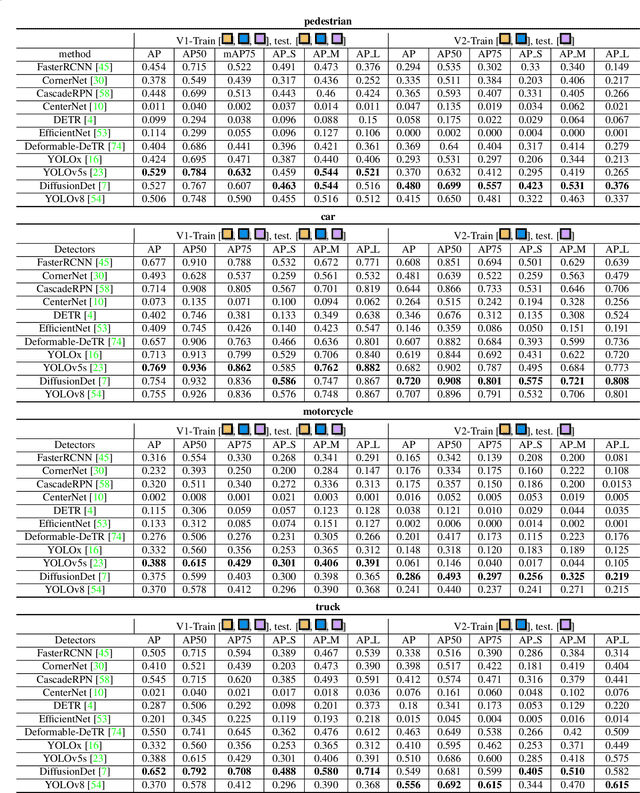Jianru Xue
IC-Mapper: Instance-Centric Spatio-Temporal Modeling for Online Vectorized Map Construction
Mar 05, 2025Abstract:Online vector map construction based on visual data can bypass the processes of data collection, post-processing, and manual annotation required by traditional map construction, which significantly enhances map-building efficiency. However, existing work treats the online mapping task as a local range perception task, overlooking the spatial scalability required for map construction. We propose IC-Mapper, an instance-centric online mapping framework, which comprises two primary components: 1) Instance-centric temporal association module: For the detection queries of adjacent frames, we measure them in both feature and geometric dimensions to obtain the matching correspondence between instances across frames. 2) Instance-centric spatial fusion module: We perform point sampling on the historical global map from a spatial dimension and integrate it with the detection results of instances corresponding to the current frame to achieve real-time expansion and update of the map. Based on the nuScenes dataset, we evaluate our approach on detection, tracking, and global mapping metrics. Experimental results demonstrate the superiority of IC-Mapper against other state-of-the-art methods. Code will be released on https://github.com/Brickzhuantou/IC-Mapper.
Redundant Queries in DETR-Based 3D Detection Methods: Unnecessary and Prunable
Dec 03, 2024



Abstract:Query-based models are extensively used in 3D object detection tasks, with a wide range of pre-trained checkpoints readily available online. However, despite their popularity, these models often require an excessive number of object queries, far surpassing the actual number of objects to detect. The redundant queries result in unnecessary computational and memory costs. In this paper, we find that not all queries contribute equally -- a significant portion of queries have a much smaller impact compared to others. Based on this observation, we propose an embarrassingly simple approach called \bd{G}radually \bd{P}runing \bd{Q}ueries (GPQ), which prunes queries incrementally based on their classification scores. It is straightforward to implement in any query-based method, as it can be seamlessly integrated as a fine-tuning step using an existing checkpoint after training. With GPQ, users can easily generate multiple models with fewer queries, starting from a checkpoint with an excessive number of queries. Experiments on various advanced 3D detectors show that GPQ effectively reduces redundant queries while maintaining performance. Using our method, model inference on desktop GPUs can be accelerated by up to 1.31x. Moreover, after deployment on edge devices, it achieves up to a 67.86\% reduction in FLOPs and a 76.38\% decrease in inference time. The code will be available at \url{https://github.com/iseri27/Gpq}.
HeightMapNet: Explicit Height Modeling for End-to-End HD Map Learning
Nov 03, 2024Abstract:Recent advances in high-definition (HD) map construction from surround-view images have highlighted their cost-effectiveness in deployment. However, prevailing techniques often fall short in accurately extracting and utilizing road features, as well as in the implementation of view transformation. In response, we introduce HeightMapNet, a novel framework that establishes a dynamic relationship between image features and road surface height distributions. By integrating height priors, our approach refines the accuracy of Bird's-Eye-View (BEV) features beyond conventional methods. HeightMapNet also introduces a foreground-background separation network that sharply distinguishes between critical road elements and extraneous background components, enabling precise focus on detailed road micro-features. Additionally, our method leverages multi-scale features within the BEV space, optimally utilizing spatial geometric information to boost model performance. HeightMapNet has shown exceptional results on the challenging nuScenes and Argoverse 2 datasets, outperforming several widely recognized approaches. The code will be available at \url{https://github.com/adasfag/HeightMapNet/}.
Abductive Ego-View Accident Video Understanding for Safe Driving Perception
Mar 01, 2024



Abstract:We present MM-AU, a novel dataset for Multi-Modal Accident video Understanding. MM-AU contains 11,727 in-the-wild ego-view accident videos, each with temporally aligned text descriptions. We annotate over 2.23 million object boxes and 58,650 pairs of video-based accident reasons, covering 58 accident categories. MM-AU supports various accident understanding tasks, particularly multimodal video diffusion to understand accident cause-effect chains for safe driving. With MM-AU, we present an Abductive accident Video understanding framework for Safe Driving perception (AdVersa-SD). AdVersa-SD performs video diffusion via an Object-Centric Video Diffusion (OAVD) method which is driven by an abductive CLIP model. This model involves a contrastive interaction loss to learn the pair co-occurrence of normal, near-accident, accident frames with the corresponding text descriptions, such as accident reasons, prevention advice, and accident categories. OAVD enforces the causal region learning while fixing the content of the original frame background in video generation, to find the dominant cause-effect chain for certain accidents. Extensive experiments verify the abductive ability of AdVersa-SD and the superiority of OAVD against the state-of-the-art diffusion models. Additionally, we provide careful benchmark evaluations for object detection and accident reason answering since AdVersa-SD relies on precise object and accident reason information.
Vehicle Behavior Prediction by Episodic-Memory Implanted NDT
Feb 13, 2024



Abstract:In autonomous driving, predicting the behavior (turning left, stopping, etc.) of target vehicles is crucial for the self-driving vehicle to make safe decisions and avoid accidents. Existing deep learning-based methods have shown excellent and accurate performance, but the black-box nature makes it untrustworthy to apply them in practical use. In this work, we explore the interpretability of behavior prediction of target vehicles by an Episodic Memory implanted Neural Decision Tree (abbrev. eMem-NDT). The structure of eMem-NDT is constructed by hierarchically clustering the text embedding of vehicle behavior descriptions. eMem-NDT is a neural-backed part of a pre-trained deep learning model by changing the soft-max layer of the deep model to eMem-NDT, for grouping and aligning the memory prototypes of the historical vehicle behavior features in training data on a neural decision tree. Each leaf node of eMem-NDT is modeled by a neural network for aligning the behavior memory prototypes. By eMem-NDT, we infer each instance in behavior prediction of vehicles by bottom-up Memory Prototype Matching (MPM) (searching the appropriate leaf node and the links to the root node) and top-down Leaf Link Aggregation (LLA) (obtaining the probability of future behaviors of vehicles for certain instances). We validate eMem-NDT on BLVD and LOKI datasets, and the results show that our model can obtain a superior performance to other methods with clear explainability. The code is available at https://github.com/JWFangit/eMem-NDT.
Vision-Based Traffic Accident Detection and Anticipation: A Survey
Aug 30, 2023



Abstract:Traffic accident detection and anticipation is an obstinate road safety problem and painstaking efforts have been devoted. With the rapid growth of video data, Vision-based Traffic Accident Detection and Anticipation (named Vision-TAD and Vision-TAA) become the last one-mile problem for safe driving and surveillance safety. However, the long-tailed, unbalanced, highly dynamic, complex, and uncertain properties of traffic accidents form the Out-of-Distribution (OOD) feature for Vision-TAD and Vision-TAA. Current AI development may focus on these OOD but important problems. What has been done for Vision-TAD and Vision-TAA? What direction we should focus on in the future for this problem? A comprehensive survey is important. We present the first survey on Vision-TAD in the deep learning era and the first-ever survey for Vision-TAA. The pros and cons of each research prototype are discussed in detail during the investigation. In addition, we also provide a critical review of 31 publicly available benchmarks and related evaluation metrics. Through this survey, we want to spawn new insights and open possible trends for Vision-TAD and Vision-TAA tasks.
Gated Driver Attention Predictor
Aug 01, 2023Abstract:Driver attention prediction implies the intention understanding of where the driver intends to go and what object the driver concerned about, which commonly provides a driving task-guided traffic scene understanding. Some recent works explore driver attention prediction in critical or accident scenarios and find a positive role in helping accident prediction, while the promotion ability is constrained by the prediction accuracy of driver attention maps. In this work, we explore the network connection gating mechanism for driver attention prediction (Gate-DAP). Gate-DAP aims to learn the importance of different spatial, temporal, and modality information in driving scenarios with various road types, occasions, and light and weather conditions. The network connection gating in Gate-DAP consists of a spatial encoding network gating, long-short-term memory network gating, and information type gating modules. Each connection gating operation is plug-and-play and can be flexibly assembled, which makes the architecture of Gate-DAP transparent for evaluating different spatial, temporal, and information types for driver attention prediction. Evaluations on DADA-2000 and BDDA datasets verify the superiority of the proposed method with the comparison with state-of-the-art approaches. The code is available on https://github.com/JWFangit/Gate-DAP.
Enhancing Mapless Trajectory Prediction through Knowledge Distillation
Jun 25, 2023Abstract:Scene information plays a crucial role in trajectory forecasting systems for autonomous driving by providing semantic clues and constraints on potential future paths of traffic agents. Prevalent trajectory prediction techniques often take high-definition maps (HD maps) as part of the inputs to provide scene knowledge. Although HD maps offer accurate road information, they may suffer from the high cost of annotation or restrictions of law that limits their widespread use. Therefore, those methods are still expected to generate reliable prediction results in mapless scenarios. In this paper, we tackle the problem of improving the consistency of multi-modal prediction trajectories and the real road topology when map information is unavailable during the test phase. Specifically, we achieve this by training a map-based prediction teacher network on the annotated samples and transferring the knowledge to a student mapless prediction network using a two-fold knowledge distillation framework. Our solution is generalizable for common trajectory prediction networks and does not bring extra computation burden. Experimental results show that our method stably improves prediction performance in mapless mode on many widely used state-of-the-art trajectory prediction baselines, compensating for the gaps caused by the absence of HD maps. Qualitative visualization results demonstrate that our approach helps infer unseen map information.
Learning Residual Model of Model Predictive Control via Random Forests for Autonomous Driving
Apr 10, 2023



Abstract:One major issue in learning-based model predictive control (MPC) for autonomous driving is the contradiction between the system model's prediction accuracy and computation efficiency. The more situations a system model covers, the more complex it is, along with highly nonlinear and nonconvex properties. These issues make the optimization too complicated to solve and render real-time control impractical.To address these issues, we propose a hierarchical learning residual model which leverages random forests and linear regression.The learned model consists of two levels. The low level uses linear regression to fit the residues, and the high level uses random forests to switch different linear models. Meanwhile, we adopt the linear dynamic bicycle model with error states as the nominal model.The switched linear regression model is added to the nominal model to form the system model. It reformulates the learning-based MPC as a quadratic program (QP) problem and optimization solvers can effectively solve it. Experimental path tracking results show that the driving vehicle's prediction accuracy and tracking accuracy are significantly improved compared with the nominal MPC.Compared with the state-of-the-art Gaussian process-based nonlinear model predictive control (GP-NMPC), our method gets better performance on tracking accuracy while maintaining a lower computation consumption.
UAV Obstacle Avoidance by Human-in-the-Loop Reinforcement in Arbitrary 3D Environment
Apr 07, 2023Abstract:This paper focuses on the continuous control of the unmanned aerial vehicle (UAV) based on a deep reinforcement learning method for a large-scale 3D complex environment. The purpose is to make the UAV reach any target point from a certain starting point, and the flying height and speed are variable during navigation. In this work, we propose a deep reinforcement learning (DRL)-based method combined with human-in-the-loop, which allows the UAV to avoid obstacles automatically during flying. We design multiple reward functions based on the relevant domain knowledge to guide UAV navigation. The role of human-in-the-loop is to dynamically change the reward function of the UAV in different situations to suit the obstacle avoidance of the UAV better. We verify the success rate and average step size on urban, rural, and forest scenarios, and the experimental results show that the proposed method can reduce the training convergence time and improve the efficiency and accuracy of navigation tasks. The code is available on the website https://github.com/Monnalo/UAV_navigation.
 Add to Chrome
Add to Chrome Add to Firefox
Add to Firefox Add to Edge
Add to Edge